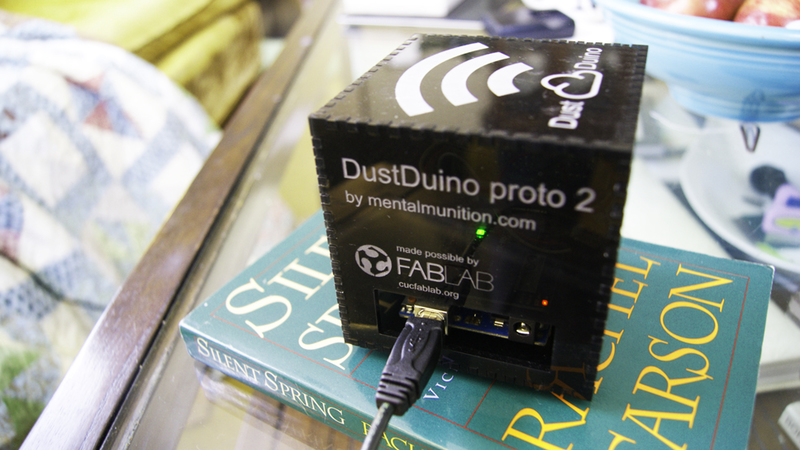
DustDuino
What is it?
DustDuino can help individuals with limited resources monitor PM10 and PM2.5 concentrations, indoors or outdoors. It uses Shinyei PPD42NS, a $15USD optical sensor that uses an LED and a lens to determine the concentration of dust in a partially closed chamber that draws in air from its surroundings. The sensor data is received by an Arduino development board and transmitted to Xively. Prototypes of DustDuino have been successfully built and used in various indoor and outdoor locations.
Also see the Data Logging page for more on setting up and using different dataloggers, and for more tutorials.
Questions
Why make one?
The health effects attributed to outdoor fine particulate matter (PM2.5) rank it among the risk factors with the highest health impacts in the world, accounting for over 3.2 million premature deaths annually. In October 2013, the World Health Organization announced they consider particulate matter, a major component of indoor and outdoor air pollution, as a Group 1 carcinogen along with tobacco smoke and asbestos.
What can the DustDuino Do?
From the Data Quality Research Note
Test results indicate that DustDuino provides accurate and useful information, albeit of a somewhat limited scope and under certain conditions. An academic study which compared the Shenyei particulate matter sensor to costlier models used by governments, researchers, and companies found that this low-cost sensor produced results equivalent to much more expensive ones when analyzing data at hourly intervals.
Testing with reference monitors conducted in Berkeley, California in late 2013 concluded that the results of the low-cost sensor were about equivalent to much more expensive ones when analyzing data at hourly intervals. ”Performance at 1 [hour] integration times was comparable to commercially available optical instruments costing considerably more.”
Testing in high PM2.5 environments such as the city of Xi'an, China also has shown high correlations between the Shenyei and reference monitors. By setting up a variety of monitors throughout the city, researchers were able to identify the High-technology Zone site as a potential PM2.5 hotspot with sustained high concentrations compared to the city average throughout the day.
There are still some unknowns with regard to the sensor - for example, whether it needs to be co-located with higher-quality instruments for calibration, and whether it could be used in extreme environments. There are also some limitations - the sensor may not produce high-quality information at time intervals shorter than an hour,
Activities
| Purpose | Category | Status | Author | Time | Difficulty | Replications |
|---|---|---|---|---|---|---|
| MACA - Open AQ monitor - Second prototype | - | - | @nanocastro | - | - | 0 replications: Try it » |
| Measure coarse and fine air particulates with a DustDuino | - | - | @Schroyer | - | - | 6 replications: Try it » |
| Dustduino potentiometer testing | - | - | @imvec | - | - | 0 replications: Try it » |
| DustDuino Sketches | - | - | @willie | - | - | 0 replications: Try it » |
| Building a DustDuino -- My first Arduino project | - | - | @MeganKierstead | - | - | 1 replications: Try it » |
| Solar Powered Air Quality Sensor | - | - | @nicholas | - | - | 0 replications: Try it » |
| Testing the Mobile DustDuino | - | - | @willie | - | - | 0 replications: Try it » |
| Visualize live sensor data with p5js and an Arduino | - | - | @warren | - | - | 0 replications: Try it » |
Activities should include a materials list, costs and a step-by-step guide to construction with photos. Learn what makes a good activity here.
Photos
Research Notes
DustDuino Sketches
The DustDuino board enables a variety of power, connectivity, and sensor configurations each of which require custom programming to process and send data. As the name would suggest, the DustDuino can be programmed with Arduino libraries and contributors to the project have made a number of Arduino sketches already. A full list of them is available on DustDuino.org
Scientific Journal Articles
| Title | Author(s) |
|---|---|
| A distributed network of low-cost continuous reading sensors to measure spatiotemporal variations of PM2.5 in Xi'an, China; January 13, 2015 PDF LINK | Meiling Gao, Junji Cao, Edmund Seto |
| Field calibrations of a low-cost aerosol sensor at a regulatory monitoring site in California; January 27, 2014. | DM Holstius et al |
External Tutorials
| Website | Overview |
|---|---|
| Mental Munitions | The original documentation blog post |
| Earth Journalism Network- Civic Science & Sensors Program | A project page reviewing EJN's sensor journalism pilot project |
News Articles
| Publication | Title |
|---|---|
| Nature | Environmental science: Pollution patrol |
| Scientific American | Dust in the Wind: How Data Visualization can Help the Environment |
| Newsweek | How Civic Science Is Changing Environmentalism |
